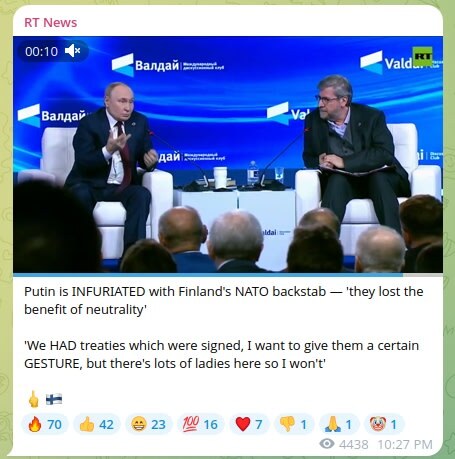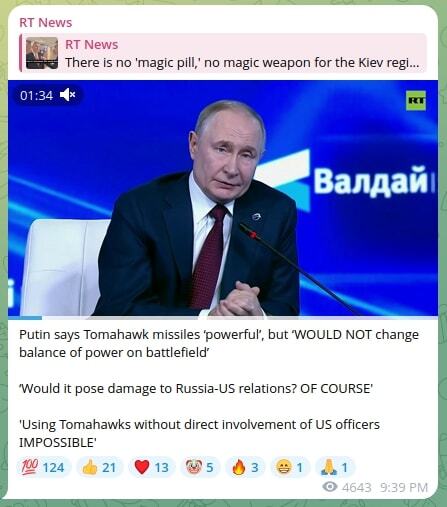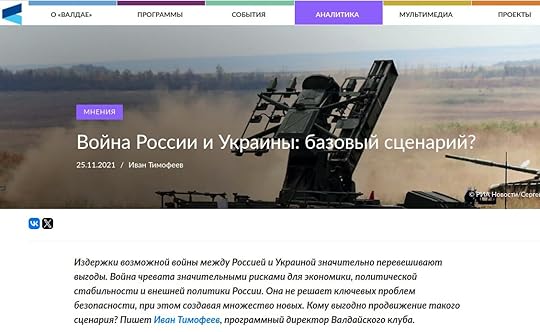Riley Waggaman: The SMO has achieved everything it was supposed to prevent in Ukraine
Riley Waggaman, Substack, 10/3/25
Riley Waggaman used to be a contributor and editor at RT. He lives in Russia.
On December 17, 2021, Moscow issued a list of security demands to NATO. The document stipulated that:
“The Participants [ the RF and NATO members ] undertake not to create conditions or situations that might represent or be regarded as a threat to the national security of the other Participants.”“The Participants exclude the deployment of medium- and shorter-range ground-based missiles in areas from which they are capable of hitting targets on the territory of other Participants.”“The Participants that are member states of the North Atlantic Treaty Organization shall make commitments that exclude further NATO expansion, including the accession of Ukraine, as well as other states.”“The Participants that are members of the North Atlantic Treaty Organization undertake to not conduct any military activity on the territory of Ukraine, as well as other states of Eastern Europe, Transcaucasia, and Central Asia.”Four days later, at a meeting with the Defense Ministry, Russian president Vladimir Putin said Moscow was prepared to take action to protect its key security interests and prevent US missile systems, which had been inching closer and closer to Russia’s borders, from being deployed to Ukraine:
If this infrastructure moves further, if US and NATO missiles appear in Ukraine, their flight time to Moscow will be reduced to 7-10 minutes, and for hypersonic weapons no more than five. For us, this represents a most serious challenge to our security.
[…]
We have issued a proposal that would rule out further NATO expansion in an easterly direction, as well as the deployment of offensive weaponry in countries adjacent to us … We need long-term, legally binding guarantees.
[…]
In the case of the continuation of the clearly aggressive line of our Western colleagues, we will take adequate retaliatory military-technical measures, responding to unfriendly steps.
As promised, Russia took military-technical measures after NATO rejected the treaty.
In his February 24, 2022 address announcing the start of the Special Military Operation in Ukraine, Putin explained that “[NATO’s] military presence in territories bordering on Russia, if we permit it to go ahead, will continue for decades to come, or maybe forever, creating an ever-mounting and totally unacceptable threat for Russia.” Military intervention was necessary in order to deter NATO from further eastward expansion, which would represent an existential threat to Moscow:
We cannot stay idle and passively observe these developments. This would be an absolutely irresponsible thing to do for us.
[…]
I reiterate: We are acting to defend ourselves from the threats created for us and from a worse peril than what is happening now.
Putin ended his address by promising that Russia would “respond immediately” to any outside attempts to interfere with the SMO. Any state or foreign actor caught trying to hinder Moscow from protecting its legitimate security interests in Ukraine would “face consequences … such as you have never seen in your entire history.”
In the nearly four years that have passed since Putin made these remarks, NATO has added two new members and turned Ukraine into a base of operations for daily attacks on Russian territory. The weapons used to carry out these attacks have been steadily increasing in range and lethality. Last month, Kiev received authorization from Washington to use US long-range missiles to strike targets deep inside Russia.
Commenting on these developments at the Valdai Discussion Club in Sochi on Thursday, Putin said he was tempted to give Finland a very rude hand gesture for joining NATO, but did not want to offend the women in the audience.
 source: RT (https://t.me/rtnews/114292)
source: RT (https://t.me/rtnews/114292)He was similarly displeased about Kiev receiving approval from Washington to use US missiles, manned by US specialists, to attack Russia from Ukrainian territory. Such attacks would be perceived by Moscow as “a new stage of escalation” that would harm US-Russia relations.
“Would [US military specialists using long-range missiles deployed to Ukraine to strike targets deep inside Russia] pose damage to our relations, where we see light at the end of the tunnel? Of course,” Putin said.
 Source: RT (https://t.me/rtnews/114280)
Source: RT (https://t.me/rtnews/114280)Who could have imagined that Putin would be making such statements more than three and a half years after announcing the start of the SMO, promising historic consequences for anyone who intervened on the side of Ukraine? As it turns out, Russia’s prestigious Valdai Club—the same international forum that Putin spoke at yesterday—predicted this exact scenario.
In an article published in November 2021, three months before the launch of the SMO, Ivan Timofeev, program director for the Valdai Club, explored the probable outcomes of Russian military intervention in Ukraine.
 Source: valdaiclub.com
Source: valdaiclub.comTimofeev imagined a scenario in which Russian forces would strike Ukraine in several directions at once. With the help of uncontested air superiority, the Russian military would either encircle Ukrainian troops in the East, or force them to withdraw to Western Ukraine. Kiev would be declared the capital of a Russia-backed Ukraine, which would include the fully liberated Donbass:
The new state would be recognized by Russia … solving several historical problems at once. An immediate threat to the southwestern borders would be removed. Full control over the Sea of Azov and the land corridor to the Republic of Crimea would be ensured. Two Ukrainian states would appear on the map, one of which is “friendly and fraternal”.
A variation of this scenario involved taking full control of Ukraine, although Timofeev believed this would lead to a prolonged insurgency by Ukrainian nationalists.
Ultimately, Valdai’s program director concluded that military intervention in Ukraine would not resolve Moscow’s core security issues. Instead, a military operation aimed at deterring further NATO aggression would likely exacerbate preexisting problems:
Such a military conflict is unlikely to be ended by any clear agreement. Victory over the Ukrainian military will not lead to a quick peace. The war could develop into a long and sluggish confrontation, especially if part of the territory (for example, Western Ukraine) remains under the control of the Ukrainian military.
[T]he conflict will inevitably lead to a sharp change in the approach to providing Ukraine with modern models of weapons and military equipment. In the United States and in the West as a whole, the new situation will be considered an emergency, and all possible means will be used to equip the Ukrainian military. In this case, all possible conventional weapons will be supplied. Large-scale military aid of the West will drag out the conflict. […]
In other words, the costs of a possible war significantly outweigh the benefits … [A war] would not solve key security problems, while creating many new ones.
Unfortunately, Timofeev’s pessimistic assessment was far too optimistic.
Russia is not battling an insurgency in Lvov. After nearly four years of war, the Russian military is fighting for control of Pokrovsk, a town located in Donetsk Oblast. Assuming Pokrovsk is eventually taken, the Russian military will then have to turn its attention to Ukraine’s major strongholds in Donbass: Kramatorsk, Sloviansk, Druzhkivka, and Kostiantynivka. Then it will be necessary to capture Zaporozhye and Kherson, capitals of Russian regions currently occupied by the Ukrainian Armed Forces. Then there is Kharkov. Then ….
In other words, there’s considerable work to be done if Moscow hopes to achieve, at the bare minimum, the worst case scenario in Ukraine as outlined by the Valdai Club.



